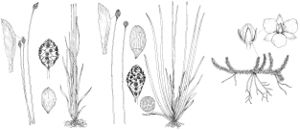Xyris jupicai
Actes de la Societe d'Histoire Naturelle de Paris 1: 106. 1792.
Herbs, annual, rarely biennial, cespitose or solitary, 10–100 cm. Stems compact. Leaves erect or ascending in narrow fans, 5–60 cm; sheaths straw-colored, light green, or brown, smooth; blade green, linear, flattened, 2–5(–15) mm wide, smooth, margins smooth or papillate. Inflorescences: scape sheaths exceeded by principal leaves; scapes linear, terete, distally oval, (0.5–)1–1.5(–2) mm wide, smooth, 1–2-ribbed, ribs papillate; spikes ovoid to ellipsoid or cylindro-lanceoloid, 7–15(–25) mm, apex acute; fertile bracts 5–7 mm, margins entire, apex rounded. Flowers: lateral sepals included, slightly curved, 5–7 mm, keel scarious, lacerate, thin; petals unfolding in morning, blade obtriangular, 3 mm; staminodes bearded. Seeds translucent, ellipsoid, 0.4–0.5 mm, faintly ribbed. 2n = 18.
Phenology: Flowering summer–fall (all year south).
Habitat: Moist sands, sandy peats of savannas, flatwoods, swales, shores, ditches, and roadsides, particularly in disturbed situations
Elevation: 0–350 m
Distribution

Ala., Ark., Del., Fla., Ga., La., Md., Miss., N.J., N.C., Okla., S.C., Tenn., Tex., Va., Mexico, West Indies, Central America, South America.
Discussion
The widest-ranging of all New World Xyrids and the most ample ecologically, Xyris jupicai is a frequent invader of disturbed or fallow open wetlands within its extensive range. In the southeastern United States it frequently shares habitat with two other species of its complex, namely X. difformis var. difformis and X. laxifolia. It differs from both in its lack of red pigmentation, from X. difformis by its more erect leaves and narrower, less prominently ribbed scapes, and from X. laxifolia by its narrower leaves and scapes, shorter, narrower, paler spikes, and translucent (rather than mealy), shorter seeds. Nonetheless, some difficult "calls" arise since all three flower at the same time and occasional chance hybrids do form.
Selected References
None.
